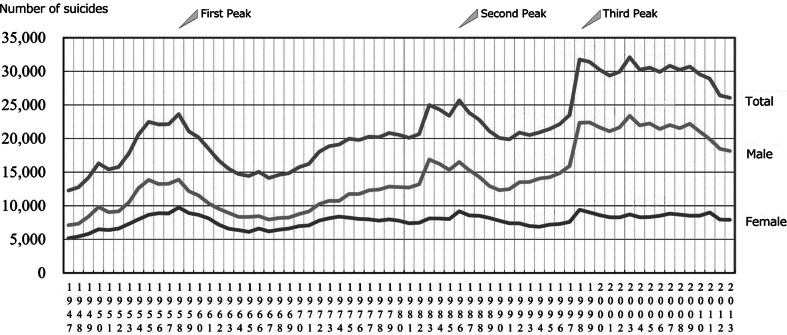I read the article by Gosavi T et al. with great interest (Gosavi et al., 2020). They have reported a study on the psychological effects of coronavirus disease-2019 (COVID-19) on relatively young, healthy men in isolation, and stated that such effects of increased isolation may be substantial even in such individuals, making preventive treatment after lockdowns essential for the long-term well-being of those affected. Their points are precise, and particularly the one on the need for ‘long-term’ mental healthcare is thought-provoking.
When examining long-term mental health, they have shown the fluctuations in the number of suicides in Japan—long-term trends in this number in post-war Japan (Fig. 1) show an increase in suicides around 1955 after World War II (the first peak in 1958), followed by a second peak in 1986, and a third peak in 1998 (White paper on suicide prevention in Japan, 2012–2015). By age group, the number of suicides among those in their late teens to early 30s, particularly among those in their early 20s, had increased during the first peak; there is a theory that this was due to the impact of the changes in post-war society values and wartime experiences. During the second peak, there were many suicides among those in their early 50s, and the economic depression has been cited as a reason for this. During the third peak, the number of suicides among those in their late 40s to early 60s, especially among those in their 50s, had increased rapidly; the prevailing theory is that this was due to the economic bubble collapse (Fushimi, Sugawara, & Shimizu, 2006; White paper on suicide prevention in Japan, 2012–2015). By gender, the increase was more pronounced among males, with females not showing as large a fluctuation (Fushimi et al., 2006; White paper on suicide prevention in Japan, 2012–2015).
Fig. 1.
Long-term trends in the number of suicides (vital statistics); source: adapted from the 2015 White Paper on Suicide Control (Cabinet Office).
These findings seem to indicate that the age when people are most susceptible to suicide has changed over time, with the increase gradually shifting from the younger age group to the middle and older age groups. However, from another point of view, those who were in their early 20s during the first peak were in their early 50s during the second, and in their late 50s to early 60s during the third. This is because about 30 years separate the first and second peaks, and about 10 years separate the second and third (i.e. these were people born around the same time). It can also be said that the main age group that saw an increase in suicides during the first peak became the main group that saw an increase during the second and third peaks as well.
Although the above does not go beyond the realm of making inferences, if young people (adolescents undergoing psychological development) grow up in social situations that lead to an increase in suicides, then they may continue to be at high risk even after reaching middle and old age. There is still insufficient evidence to prove this inference, and more studies and data collection are needed in the future. In addition to studies on suicide, research on traumatic experiences during the psychological development stage may be needed as well.
In Japan, there have been concerns over the increasing trend of suicide among young people in the last few years. In addition, there are concerns about the increase in suicides, including among young people, due to the COVID-19 pandemic (Fushimi, 2021a, b). The pandemic has led to many issues such as long-term anxiety and distress, increase in physical distance between people, loneliness and isolation, and loss of employment (Fushimi, 2021a, b). Accordingly, there is a concern that if social situations deteriorate due to the pandemic and there is an increase in suicides, especially among youth, this may have a lasting impact, extending decades into the future or even longer. Another concern is that even if today's youths reach middle and old age, this age group may continue to be at risk of suicide. I would like to emphasize that implementation of measures to prevent this is essential for the long-term healthcare of young people.
Conflict of interest
None.
References
- Fushimi, M. (2021a). Student mental health consultations at a Japanese university and the current state of affairs on the increase in suicide victims in Japan during the COVID-19 pandemic. Psychological Medicine, 1–2. doi: 10.1017/S0033291721001240. [DOI] [PubMed] [Google Scholar]
- Fushimi, M. (2021b). The importance of studying the increase in suicides and gender differences during the COVID-19 pandemic. QJM, hcab130. doi: 10.1093/qjmed/hcab130. [DOI] [PMC free article] [PubMed] [Google Scholar]
- Fushimi, M., Sugawara, J., & Shimizu, T. (2006). Suicide in Akita Prefecture, Japan. International Psychiatry, 3(1), 3–5. doi: 10.1192/S1749367600001405. [DOI] [PMC free article] [PubMed] [Google Scholar]
- Gosavi, T., Koh, J., Rosman, M., Prasad, K., Doshi, K., Lim, E., … Tan, E. (2020). Psychological impact of isolation due to COVID-19 among young and fit dormitory residents. Psychological Medicine, 1–2. doi: 10.1017/S0033291720004274. [DOI] [PMC free article] [PubMed] [Google Scholar]
- White paper on suicide prevention in Japan: digest version (2012–2015). Cabinet Office, Government of Japan. Retrieved from https://dl.ndl.go.jp/info:ndljp/pid/10226215?tocOpened=1.



